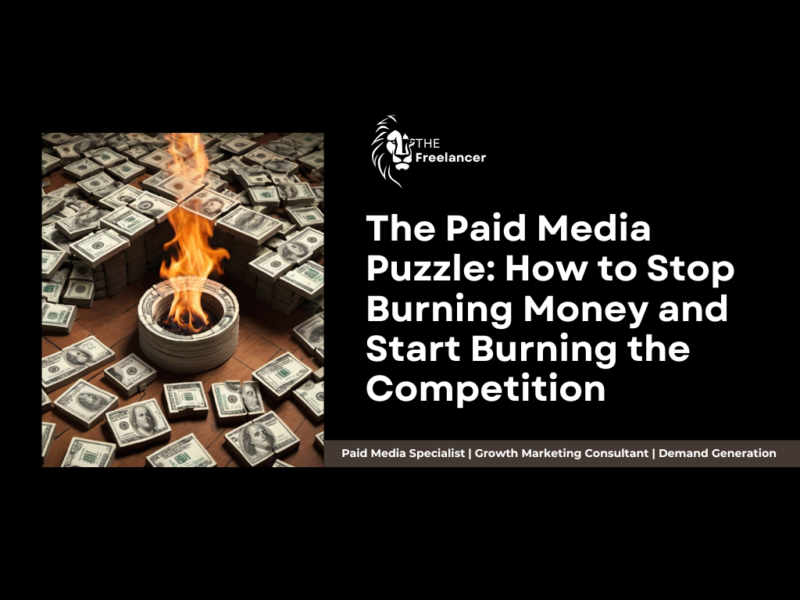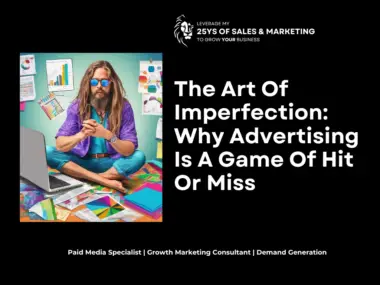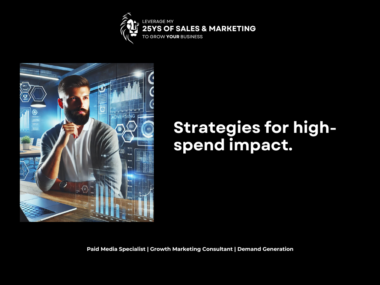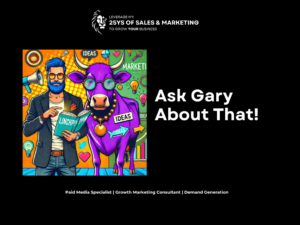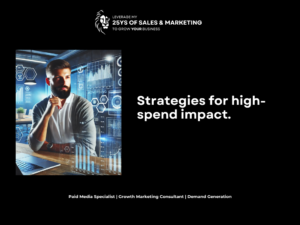Picture this: You’re a contestant on a cooking show, tasked with creating a gourmet meal. The catch? You’re blindfolded, the ingredients are unlabelled, and Gordon Ramsay is breathing down your neck. Sounds like a recipe for disaster, right? Well, welcome to the world of paid media campaigns in 2024!
If you’ve ever felt like you’re throwing money into a digital black hole with little to show for it, you’re not alone. In today’s fast-paced, ever-changing digital landscape, running successful paid media campaigns can feel like trying to hit a moving target while riding a unicycle. Backwards. In a hurricane.
But fear not, intrepid marketer! In this article, we’ll unravel the mysteries of paid media campaigns, exploring why starting small is the new thinking big, why ongoing testing is your new best friend, and how understanding the cultural quirks of different platforms can make or break your campaign. We’ll also dive into the often-overlooked strategy of bringing in a freelance media buyer to supercharge your efforts. So buckle up, buttercup – we’re about to turn that money pit into a gold mine!
The Money Pit: Common Mistakes in Paid Media Campaigns
Let’s start by addressing the elephant in the room – or should I say, the stack of cash in the room that’s slowly catching fire. Here are some common mistakes that turn paid media campaigns into expensive confetti:
1. The “Spray and Pray” Approach: Ah, the classic strategy of throwing money at every platform and hoping something sticks. It’s about as effective as trying to catch fish by draining the ocean.
2. The “One Size Fits All” Delusion: Using the same ad across all platforms is like wearing a tuxedo to the beach. Sure, you look fancy, but you’re also sweaty and covered in sand.
3. The “Set It and Forget It” Trap: Launching a campaign and then ignoring it is like planting a garden and never watering it. Don’t be surprised when all you grow is weeds (and angry comments from your CFO).
4. The “Overnight Success” Fantasy: Expecting immediate results from your campaigns is like expecting to win an Olympic gold medal after your first jog around the block. Spoiler alert: it doesn’t happen.
5. The “I Can Do It All” Syndrome: Thinking you can master every aspect of paid media without expert help is like trying to be a one-man band – you might make some noise, but it’s unlikely to be a chart-topper.
Start Small, Dream Big: The Power of Pilot Campaigns
Now that we’ve covered what not to do, let’s talk about a smarter approach – starting small. Think of it as being a big fish in a small pond, rather than a minnow in the ocean.
Starting with pilot campaigns allows you to:
1. Test the waters without emptying your bank account
2. Gather valuable data to inform larger campaigns
3. Identify potential issues before they become expensive problems
4. Build confidence and expertise in a controlled environment
Pro Tip: When setting up a pilot campaign, choose a specific audience segment and platform. For example, if you’re selling artisanal beard oils, start with Instagram ads targeting hipsters in Shoreditch. It’s specific, it’s manageable, and it’s probably where your target audience is hanging out anyway.
The Never-Ending Story: Ongoing Testing and Optimisation
Remember that garden analogy? Well, successful paid media campaigns are like prize-winning roses – they need constant care, attention, and the occasional pruning.
Ongoing testing and optimisation involve:
1. A/B testing different ad creatives, copy, and targeting options
2. Regularly reviewing performance metrics and adjusting accordingly
3. Staying updated with platform changes (because Facebook likes to keep us on our toes)
4. Continuously refining your audience targeting
5. Experimenting with new ad formats and placements
Think of it as digital Darwinism – only the fittest (and most optimised) campaigns survive.
Know Your North Star: Setting Clear Benchmarks
Without clear benchmarks, running a paid media campaign is like playing darts in the dark – you might hit something, but it probably won’t be the bullseye.
When setting benchmarks:
1. Define what success looks like for your specific business
2. Choose relevant KPIs (Key Performance Indicators) for your campaign type
3. Balance short-term wins (like click-through rates) with long-term goals (like customer lifetime value)
4. Set realistic timelines for achieving your goals
5. Establish a system for regular reporting and analysis
Remember, your North Star should guide you, not blind you. Be prepared to adjust your course as you gather more data.
B2B vs B2C: A Tale of Two Strategies
Ah, the age-old battle of B2B versus B2C. It’s like comparing apples and oranges, if apples wore suits and oranges spent too much time on TikTok.
For B2B:
– Platform selection: Think LinkedIn, industry-specific platforms, and maybe Facebook if you’re feeling adventurous
– Content: Whitepapers, case studies, and anything that screams “I’m a serious business person doing serious business things”
– Tone: Professional, authoritative, and just a touch of “I know big words”
– Targeting: Job titles, company size, industry verticals
– Sales cycle: Longer, often requiring multiple touchpoints
For B2C:
– Platform selection: Facebook, Instagram, TikTok, and anywhere else the hipsters are hanging out these days
– Content: Eye-catching visuals, snappy copy, and enough emojis to make a teenager proud
– Tone: Casual, relatable, and just a sprinkle of “How do you do, fellow kids?”
– Targeting: Demographics, interests, behaviours
– Sales cycle: Shorter, often impulse-driven
The key is to understand your audience and meet them where they are – both literally (platform choice) and figuratively (content and tone).
The Cultural Compass: Navigating Platform Dynamics
Each social media platform is like a different country, complete with its own language, customs, and unspoken rules. Post a TikTok-style video on LinkedIn, and you might as well be wearing a sombrero in Sweden – it’s going to raise some eyebrows.
Understanding platform dynamics involves:
1. Learning the “personality” of each platform (LinkedIn is the office, Instagram is the cool café, TikTok is the high school talent show)
2. Adapting your message to fit the platform culture (No one wants to see a dancing CEO on LinkedIn… or do they?)
3. Staying up-to-date with platform trends (Remember when everyone was doing the Ice Bucket Challenge? No? Just me? Okay.)
4. Understanding the unique features and ad formats of each platform
5. Recognising how user behaviour differs across platforms
Pro Tip: Spend time on each platform as a user before you start advertising. It’s like learning the local customs before you visit a new country – it’ll help you avoid those embarrassing cultural faux pas.
The Secret Weapon: Hiring a Freelance Media Buyer
Now, here’s where things get interesting. Imagine you’re trying to learn a new language. Sure, you could fumble through phrasebooks and apps, or you could hire a tutor who’s fluent and can teach you the nuances. That’s what a freelance media buyer can do for your paid media campaigns.
Why consider a freelance media buyer?
1. Expertise on Tap: They’ve been in the trenches and know the ins and outs of multiple platforms.
2. Fresh Perspective: Sometimes you need an outside eye to spot opportunities (or disasters) you might miss.
3. Flexibility: Unlike a full-time hire, you can bring them in as needed for specific campaigns or periods.
4. Cost-Effective Learning: It’s like getting a master class in paid media, tailored to your business.
5. Network Access: Good freelancers often have connections with platform reps and other experts.
How to Make the Most of a Freelance Media Buyer:
1. Clear Communication: Be upfront about your goals, budget, and expectations.
2. Soak Up Knowledge: Don’t just hand over the reins – learn from their process and decision-making.
3. Regular Check-ins: Set up weekly or bi-weekly meetings to review performance and strategy.
4. Gradual Transition: As you learn, start taking on more responsibilities yourself.
5. Long-term Relationship: Even as you bring things in-house, keep them on retainer for advice and audits.
Remember, the goal isn’t just to have someone run your campaigns – it’s to build your own expertise while getting results.
From Freelance to In-House: The Transition
So, you’ve worked with a freelance media buyer, learned the ropes, and now you’re ready to bring things in-house. Congrats! But before you cut ties with your freelance guru, consider this transition plan:
1. Audit Your Knowledge: Identify areas where you feel confident and areas where you still need support.
2. Gradual Handover: Start by taking over one platform or campaign type at a time.
3. Document Everything: Create playbooks and standard operating procedures based on what you’ve learned.
4. Build Your Team: If budget allows, consider hiring a junior media buyer to train under you.
5. Retain Your Freelancer: Keep them on a reduced retainer for monthly strategy sessions or audits.
Remember, the digital landscape is always changing. Having a connection to an experienced freelancer can be invaluable as you navigate new challenges.
Conclusion: Putting It All Together
Congratulations! You’ve made it through the paid media jungle, armed with knowledge, a sense of humour, and hopefully, a renewed enthusiasm for digital marketing.
Let’s recap our key points:
1. Start small with pilot campaigns
2. Test and optimise continuously
3. Set clear benchmarks
4. Understand the differences between B2B and B2C strategies
5. Navigate platform dynamics like a cultural anthropologist
6. Consider hiring a freelance media buyer to accelerate your learning and results
7. Plan for a smooth transition when bringing paid media in-house
Remember, running successful paid media campaigns is more marathon than sprint. It’s a constant process of learning, adapting, and occasionally facepalming when you realise you’ve been targeting retirees for your youth-oriented energy drink.
But here’s the good news: with patience, persistence, and the strategies we’ve discussed, you can turn that money pit into a treasure trove. And with the help of a skilled freelance media buyer, you might just find yourself becoming the expert you always wished you had.
So go forth, brave marketer! May your CTRs be high, your CPCs be low, and may the algorithm be ever in your favour. And remember, if you ever feel overwhelmed, there’s a freelance media buyer out there ready to be your digital marketing spirit guide.
And if all else fails, there’s always interpretive dance as a marketing strategy. Hey, it could work – just make sure to A/B test it first!
